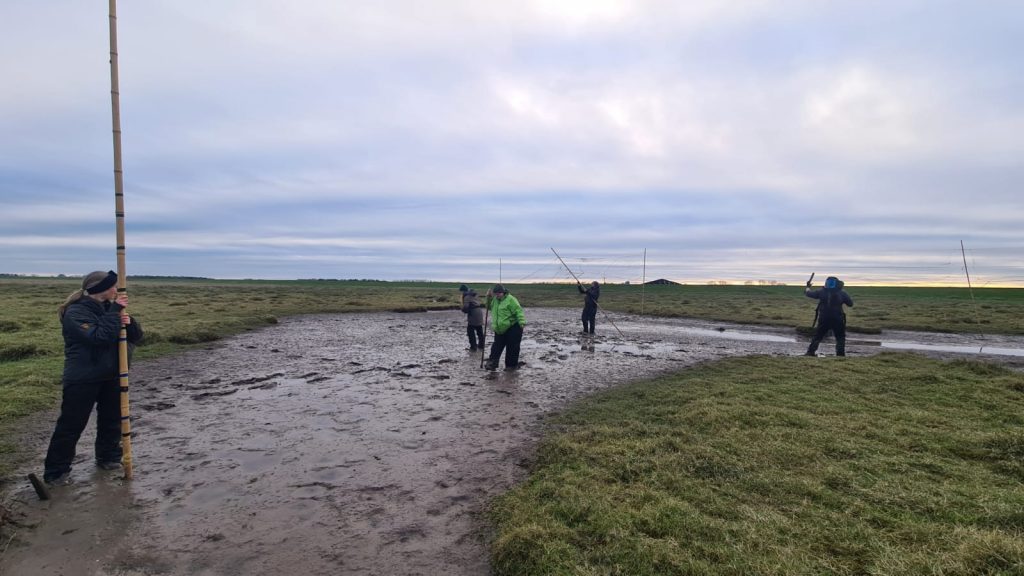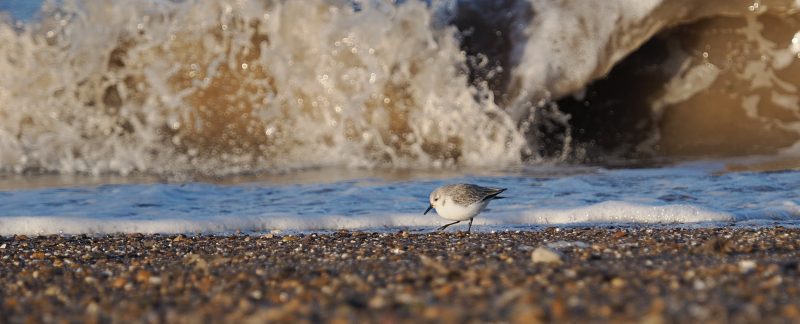Friday 12 January
Mark was on hand to kick the weekend off as he headed to Heacham and Snettisham to recce for possible cannon-net catches for the Saturday morning. The Tump was quiet with no Oystercatcher present, and further along towards Heacham there were Sanderling, Turnstone and a few Oystercatcher scattered along the beaches, but nothing providing a suitable catching option. Thus, it was decided that Saturday morning would be a resighting morning.
Later that evening, 13 team members gathered at base house and enjoyed Cathy’s now famous baked potatoes, Eton mess and good company.
Saturday 13 January
Everyone was up at 06:15, ready to head out in the dark at 06:45 to make the most of the early high tides.
- Cathy and Claudia covered the inland fields and beach at Heacham South. They found one large flock of 179 Curlew on an inland field, but Heacham South beach was quiet.
- Snettisham Beach and sailing club were covered by Sam, Shannon and Ed. A medium-sized flock of around 300 Oystercatcher were roosting just south of the sailing club. Once the tide started ebbing, small flocks of Turnstone and Sanderling joined them in Sailing Club Bay. Once the mud exposed, several hundred Bar-tailed Godwit, Curlew and Grey Plover came to feed close inshore enabling some flags to be read.
- Katharine and Liam covered Heacham North. At Heacham NN, there were small flocks of Turnstone and Sanderling being moved around a lot by dog walkers. Further down towards Snettisham dam there were some Curlew and Bar-tailed Godwit on the mud close enough for some flag reading.
- Luke and David covered Holme and Hunstanton. The Oystercatcher roost at Holme was sizeable (1,500 birds) but too distant for any ring reading. Hunstanton proved more fruitful, with David even managing to read a metal ring on an Oystercatcher. A Purple Sandpiper added some extra excitement.
- Mark, Lucy, Skye and James remained at the base to prepare kit for the evening’s mist-netting attempt and to make breakfast. They were joined by Michele and Nick. By the time the resighting teams returned the trailer was packed, and there was piping hot porridge and a superb full English breakfast waiting.
There was just time for an hour of rest before we headed out and set the mist nets for the evenings catch attempt. David gave a briefing, then everyone bar Sam and Michele – who remained behind to prep dinner – headed onto Terrington Marsh. Due to the probability of a surge tide, it was decided that the two ‘inner’ pools would be best to target.
The team split in two, with six people led by David setting on White Barn Pool (WBP) and six led by Mark on the ‘E’ Pool (EP). WBP was dry with virtually no evidence of any waders in the mud, although it was clearly popular with Brents. There was even a brief discussion about whether there was any point in setting the nets at all! Eventually, a T shape of five nets and a line of two on a smaller pool nearby were set. Things looked a bit more promising on EP, and an E shaped set-up of seven nets was up in no time. Mark remained to keep an eye on the nets, whilst everyone else was back at base by 16:15 enjoying soup, bread and chocolate cake (although not all at the same time).

We were back on the road at 17:00, and the sound lures were on at the nets by 17:30. There was early promise, with WBP catching two Dunlin before the lures even went on. Then, it was a case, as it always is, of waiting for the tide to do its thing and hoping the birds obliged. Birds were steadily coming in, and by 19:00 we were up to 30 birds. At WBP, we could hear what sounded like sizeable flocks of birds moving around in the darkness, then, close to high tide a call came over the radio from E Pool… “we need reinforcements.”
David, Shannon and Ed were dispatched from WBP, taking birds off as they went. On the way back out to EP, it was obvious that the tide was coming in even further than expected, and it looked, we assumed, quite close to the WBP nets. The next set of radio messages went something like this:
“WBP team, we can see the tide coming quite close, is there water out there?”
“Yes! White Barn Pool is now full and getting towards knee-deep in places.”
EP was also underwater, with the teams knee-deep in water quickly and efficiently extracting birds at both sets of nets. Most birds were on the seaward side of the nets, suggesting they had been pushed off the outer pool, which is now the more usual site for mist-netting at Terrington. A furling stick floating past whilst taking a bird out of a net was a unique experience. Most other kit was grabbed before the tide made off with it, but one set of speakers did get a little soggy, and is currently drying out, we hope without any permanent damage. Birds, and those team members who were particularly cold and/or wet headed off the marsh from EP whilst the rest of the team remained to take down the nets.
As WBP team were still only three strong, and had over twenty birds to carry off and nets on two pools to take down, David and Ed went back out again to help them. At the last minute, Katharine and Nick decided to join too. At this point, the marsh was completely underwater, and David had expertly used a GPS (with some gentle probing of the ground with a furler) to find a safe route across the first ditch. Katharine and Nick were only a few metres behind but managed to find the edge of the causeway that crosses the ditch. Katharine disappeared up to her neck in the ditch, with Nick closely following (reminding us all why we always walk in single file and use ‘proders’!). Luckily, they were able to get out quickly and straight back to the barn to get dry and warm up. Having Mark’s van down there to provide some heat was a huge relief.
Eventually, all kit was taken down and everyone was off the marsh. Those that were wet and cold were wonderfully looked after by the rest of the team, with hot drinks and spare clothes being handed out. It wasn’t long before we were ringing and processing the birds.
Despite being a small team, a total of 155 birds were ringed and processed in the next two and a half hours, including flagging an amazing 72 Knot! Special mention should go to Skye (6 years old) and James (9 years old) for their Knot holding and photo-taking skills in the colour-marking team, and to Hilary for keeping the ringing and processing teams supplied with boxes through lightning-fast cleaning. By 00:50, we were finished, packed up and headed back to base for a well-earned sleep.
It later turned out the tide had surged by 40 cm, explaining why the whole marsh had gone under water.
Ringing Totals
| Species | New | Retrap | Total |
| Oystercatcher | 10 | – | 10 |
| Bar-tailed Godwit | 3 | – | 3 |
| Dunlin | 45 | – | 45 |
| Redshank | 10 | 2 | 12 |
| Turnstone | 4 | 2 | 6 |
| Knot | 79 | – | 79 |
| Totals | 151 | 4 | 155 |
Colour-mark Resighting Totals
| Species | Sightings | individuals |
| Bar-tailed Godwit | 5 | 5 |
| Curlew | 7 | 6 |
| Turnstone | 7 | 5 |
| Grey Plover | 2 | 1 |
| Sanderling | 1 | 1 |
| Oystercatcher | 1 | 1 |
| Total | 23 | 19 |
After our busy night, the late arrival back to base and no cannon-netting option, Sunday morning was dedicated to sorting kit and cleaning the house. Various team members departed during the morning, with some remaining for another cooked breakfast before heading home mid-afternoon.
Thanks to Ed Tooth for writing this report. Cover photo by Cathy Ryden.

